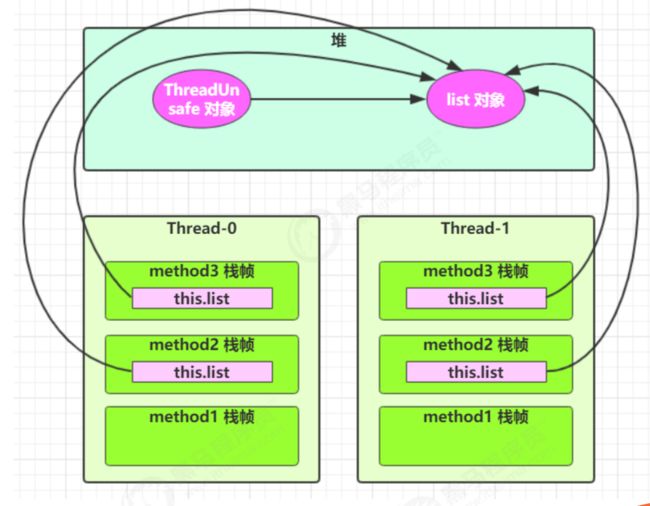4.4 变量的线程安全分析
目录
-
- 4.4 变量的线程安全分析
-
- 1、成员变量和静态变量是否线程安全?
- 2、局部变量是否线程安全?
- 3、局部变量线程安全分析
- 4、常见线程安全类
- 5、实例分析
- 4.5 习题
-
- 1、卖票练习
- 2、转账练习
4.4 变量的线程安全分析
1、成员变量和静态变量是否线程安全?
- 如果它们没有共享,则线程安全
- 如果它们被共享了,根据它们的状态是否能够改变,又分两种情况
- 如果只有读操作,则线程安全
- 如果有读写操作,则这段代码是临界区,需要考虑线程安全
2、局部变量是否线程安全?
- 局部变量是线程安全的
- 但局部变量引用的对象则未必
- 如果该对象没有逃离方法的作用访问,它是线程安全的
- 如果该对象逃离方法的作用范围,需要考虑线程安全
3、局部变量线程安全分析
2) 安全分析1 - 局部变量是引用数据类型,且没有逃离方法的作用域
先看一个成员变量的例子:
public class TestThreadSafe {
static final int THREAD_NUMBER = 2;
static final int LOOP_NUMBER = 200;
public static void main(String[] args) {
ThreadUnsafe test = new ThreadUnsafe();
for (int i = 0; i < THREAD_NUMBER; i++) {
new Thread(() -> {
test.method1(LOOP_NUMBER);
}, "Thread" + (i+1)).start();
}
}
}
class ThreadUnsafe {
ArrayList<String> list = new ArrayList<>();
public void method1(int loopNumber) {
for (int i = 0; i < loopNumber; i++) {
method2();
method3();
}
}
private void method2() {
list.add("1");
}
private void method3() {
list.remove(0);
}
}
将 list 修改为局部变量,那么就不会有上述问题了
list 是局部变量,每个线程调用时会创建其不同实例,没有共享
class ThreadSafe {
public final void method1(int loopNumber) {
ArrayList<String> list = new ArrayList<>();
for (int i = 0; i < loopNumber; i++) {
method2(list);
method3(list);
}
}
public void method2(ArrayList<String> list) {
System.out.println("+1");
list.add("1");
}
public void method3(ArrayList<String> list) {
System.out.println("-1");
list.remove(0);
}
}
3)安全分析3 - 局部变量引用对象,且对象逃离了方法的作用范围
此时是线程不安全的
public static StringBuilder method3(){
StringBuilder s1 = new StringBuilder();
s1.append("A");
s1.append("B");
...
return s1;
}
4)方法访问修饰符带来的思考,如果把 method2 和 method3 的方法修改为 public 会不会代理线程安全问题?
情况1:有其它线程调用 method2 和 method3
情况2:在 情况1 的基础上,为 ThreadSafe 类添加子类,子类覆盖 method2 或 method3 方法,即
class ThreadSafeSubClass extends ThreadSafe{
@Override
public void method3(ArrayList<String> list) {
// System.out.println(2);
new Thread(() -> {
list.remove(0);
}).start();
}
}
class ThreadSafe {
public final void method1(int loopNumber) {
ArrayList<String> list = new ArrayList<>();
for (int i = 0; i < loopNumber; i++) {
method2(list);
method3(list);
}
System.out.println(list.size());
}
public void method2(ArrayList<String> list) {
// System.out.println("+1");
list.add("1");
}
public void method3(ArrayList<String> list) {
// System.out.println("-1");
list.remove(0);
}
}
public class TestThreadSafe {
static final int THREAD_NUMBER = 2;
static final int LOOP_NUMBER = 200;
public static void main(String[] args) {
ThreadSafeSubClass test = new ThreadSafeSubClass();
for (int i = 0; i < THREAD_NUMBER; i++) {
new Thread(() -> {
test.method1(LOOP_NUMBER);
}, "Thread" + (i+1)).start();
}
}
}
4、常见线程安全类
String
Integer
StringBuffer
Random
Vector
Hashtable
java.util.concurrent 包下的类
这里说它们是线程安全的是指,多个线程调用它们同一个实例的某个方法时,是线程安全的。
- 它们的每个方法是原子的
- 但注意它们多个方法的组合不是原子的,见后面分析
5、实例分析
4.5 习题
1、卖票练习
public class ExerciseSell {
public static void main(String[] args) throws InterruptedException {
// 模拟多人买票
TicketWindow window = new TicketWindow(1000);
// 所有线程的集合
List<Thread> threadList = new ArrayList<>();
// 卖出的票数统计
List<Integer> amountList = new Vector<>();
for (int i = 0; i < 2000; i++) {
Thread thread = new Thread(() -> {
// 买票
int amount = window.sell(random(5));
// 统计买票数
amountList.add(amount);
});
threadList.add(thread);
thread.start();
}
//等待所有的线程运行结束
for (Thread thread : threadList) {
thread.join();
}
// 统计卖出的票数和剩余票数
log.debug("余票:{}", window.getCount());
log.debug("卖出的票数:{}", amountList.stream().mapToInt(i -> i).sum());
}
// Random 为线程安全
static Random random = new Random();
// 随机 1~5
public static int random(int amount) {
return random.nextInt(amount) + 1;
}
}
// 售票窗口
class TicketWindow {
private int count;
public TicketWindow(int count) {
this.count = count;
}
// 获取余票数量
public int getCount() {
return count;
}
// 售票
/*public synchronized int sell(int amount) {
if (this.count >= amount) {
this.count -= amount;
return amount;
} else {
return 0;
}
}*/
public int sell(int amount) {
if (this.count >= amount) {
this.count -= amount;
return amount;
} else {
return 0;
}
}
}
2、转账练习
public class ExerciseTransfer {
public static void main(String[] args) throws InterruptedException {
Account a = new Account(1000);
Account b = new Account(1000);
Thread t1 = new Thread(() -> {
for (int i = 0; i < 1000; i++) {
a.transfer(b, randomAmount());
}
}, "t1");
Thread t2 = new Thread(() -> {
for (int i = 0; i < 1000; i++) {
b.transfer(a, randomAmount());
}
}, "t2");
t1.start();
t2.start();
t1.join();
t2.join();
// 查看转账2000次后的总金额
log.debug("total:{}", (a.getMoney() + b.getMoney()));
}
// Random 为线程安全
static Random random = new Random();
// 随机 1~100
public static int randomAmount() {
return random.nextInt(100) + 1;
}
}
// 账户
class Account {
private int money;
public Account(int money) {
this.money = money;
}
public int getMoney() {
return money;
}
public void setMoney(int money) {
this.money = money;
}
// 转账
/*public void transfer(Account target, int amount) {
if (this.money >= amount) {
this.setMoney(this.getMoney() - amount);
target.setMoney(target.getMoney() + amount);
}
}*/
public void transfer(Account target, int amount) {
synchronized(Account.class) {
if (this.money >= amount) {
this.setMoney(this.getMoney() - amount);
target.setMoney(target.getMoney() + amount);
}
}
}
// 方法上加synchronized,锁对象是this, a向b转账使用的锁对象是Account a,
// b向a转账使用的锁对象是Account b,两个线程使用的是不同的锁对象,所以不能控制线程安全
/* public synchronized void transfer(Account target, int amount) {
if (this.money > amount) {
this.setMoney(this.getMoney() - amount);
target.setMoney(target.getMoney() + amount);
}
}*/
}



